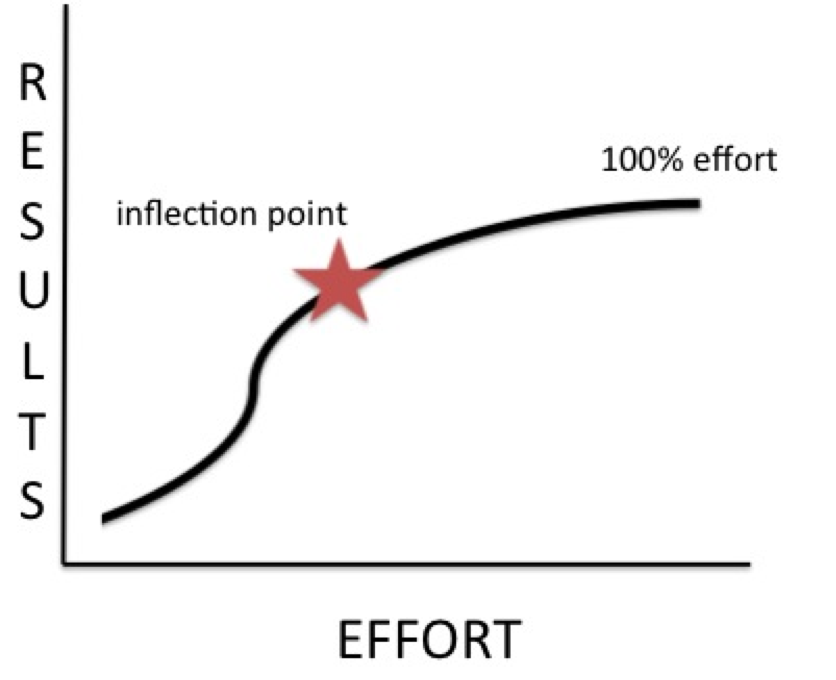Do you run a small business? Or does your small business run you?
As an entrepreneur, there are an unlimited number of things we could do in order to grow or improve our businesses. It is easy to keep 100 hours a week. I know I have done so countless times throughout my career.
"Some entrepreneurs have been “programmed” to work all of the time."
Unfortunately, we often convince ourselves that we MUST work those kinds of hours in order to be successful.
The reality is that there is a point of diminishing returns. Although more work might produce greater results, the return on the additional effort decreases significantly.
We Work Too Hard
Why do we work so hard?
Sometimes it is because we do indeed have a lot on our plates. Or maybe we have too many plates.
But more often than not, we work around the clock for other reasons.
Some entrepreneurs have been “programmed” to work all of the time. They feel like slackers if they not on their computer writing, on the phone making calls, or meeting with people.
Others worry that if they don’t complete every task, their business may tank. Or, their goal is to make as much money as possible and therefore they want to squeeze out every last drop of possible revenue.
Then there are those individuals who wouldn’t know what to do with their free time if their business didn’t keep them occupied; they don’t have a life outside of work.
And finally there are others who are workaholics because it allows them to avoid dealing with difficult issues in their life.
As a result, too many business owners and entrepreneurs work too much.
But what if you were only allowed to work one hour a day? What would you do?
I have been experimenting with this concept for nearly a year and have been relatively successful at keeping my time invested in my current business to about 20 hours a month (yes, you read that right, a month).
Why am I doing this? There are two main reasons:
1. It Forces Focus
Each morning I ask myself, what is the one thing I need to do today? What is the one thing that will create the most value? What is the one thing that only I can do? And that is the activity that I engage in for the day. I delete, defer, or delegate everything else.

Instead of keeping myself busy and climbing to the top of the “S” curve, I stop at the inflection point; the point of diminishing returns (the star). Pareto would say that 20% of the effort provides 80% of the results. Whether it is 20% or 40% is not important. The key is to find the point where more effort starts producing fewer results, and only you can decide that.
Will you extract 100% of the potential value? Probably not. But is squeezing out an extra 20% of value really worth 4 or 5 times the effort? That’s your choice.
The key is to focus on activities that will create leverage and will maximize results.
2. Create a New S Curve
What will you do with your free time?
You could of course take a vacation or spend more time with family. You could engage in work that you believe is more meaningful. You could volunteer and give back to society.
Or you could create a new S-curve.
Instead of squeezing out those few extra drops from your current business model where there are diminishing returns, start building a new business or business model that leverages your past success and creates entirely new revenue opportunities.
With the extra time created, I’ve been working on a new book that targets a completely different market for me. I’m working on a television show concept. And I am creating new products that leverage my intellectual property.
These items take upfront effort. But when they are done and have built up momentum, I will spend less time on those businesses, freeing me to create new revenue streams.
I am also developing new relationships that leverage my existing content. For example, my content has been licensed to a training company that is now delivering my material to their clients. It doesn’t take any of my time, yet I get residual income. And these relationships free me up even more, allowing me to focus again. Clearly this strategy requires extraordinary partnerships. And as they do more, I can do less.
To be clear, I am not suggesting you do a half-assed job. This will kill your business in the long run.
And, this strategy admittedly works best for a business that has momentum; where you are already successful. Once you are successful, you can then reap the rewards. You can implement processes that others can execute. You then you delegate, defer, license, automate, or eliminate the things that are not critical.
3. The 20/80/80 Rule
I call this “The 20/80/80 Rule.”
If you spent only 20% of your time extracting 80% of the revenue from your existing business model, this gives you 80% of your time to do something different – something more fulfilling, something more enjoyable.
Or, you can then invest your freed up 80% on new business models that have greater long-term potential.
4. Don’t Put the “NO” in InNOvation
When I first wrote about this concept, many people (as expected) pushed back.
Their response, “That’s easier said than done.”
Well of course! Everything is easier said than done! It is easier for me to say, “I’m going to tie my shoes,” than it is to actually tie them. But I still do it.
We look for excuses as to why we can’t do something. We blame our parents. We blame our circumstances. We blame the government. We blame our family. We blame our employer or boss.
Instead of finding reasons why something won’t work, get creative about how to make it work. Ask yourself, “How can I apply the underlying principles to my specific situation?” Even if you can’t apply the concept in its entirety, look for the nuggets that you can use.
5. Avoid the 100% Mentality
Think about your business and where you invest your time, money, and energy.
I love this statistic from Jeff Olson, author of The Agile Manager’s Guide to Getting Organized: “ Perfectionism costs 50% or more of the total effort to squeeze out the last 10% or so of quality.”
Never strive for perfection. Avoid the 100% mentality.
If you are going to work less, you need to become masterful at knowing what to stop doing.
Ditch your worst customers - Look at your customers. Instead of trying to get more customers, ask, “Which customers should I get rid of?” Admit it, there are customers that generate less income than others, yet take up most of your time. I find that the customers who are most price-sensitive are also the most difficult. I spend more time with them than I do with my best customers. The solution? Ditch the 20% that are sucking up your time. This not only frees up some hours in your day, it frees up your mental energy. Stress is created by your worst customers, not your best. Ok, I realize that when money is tight, this can seem like a risky proposition. Well, it is! But admit it, you intuitively know that attempting to keep 100% of your customers 100% happy will keep you working 100 hours a week and ultimately limit your true growth potential. Or as the comedian Bill Cosby reputedly said, “I don't know the key to success, but the key to failure is trying to please everybody.”
Ditch your lowest return activities - Look at the work you do. Look at your to do list. You will never get 100% of the work done, even if you had 200 hours in a week. Regardless, we still strive to get 100% done. Again, this mentality limits your growth potential. Instead of asking, “How can I get as much done as possible?” ask, “What should I stop doing?” or “What are the things I must do?” Or better yet, ask, “What is the one thing that will unlock the greatest growth potential for my business? What gives me leverage?” Be honest. What would happen if you got one less thing done off your to do list? Two less things? Find the sweet spot of where you can get the optimal return. Only do what you need to do, and get the rest off of your plate. And no, you are not the only one who can do most of your activities. It might feel that way, but it is not true. And believing it will kill you.
Ditch unnecessary clutter and belongings – If you are going to use this mindset of freeing your time, you may want to free yourself from current lifestyle burdens. When I moved from a 3-bedroom house in New Jersey to a small one-bedroom furnished flat in London, I got rid of nearly all of my belonging; fitting everything into two boxes. From this process I learned that there is a liberation that comes from not having a lot of things and from living the simplest life possible. There’s less clutter around you, therefore, there are less things to worry about. And because you’re spending less money, you don’t have to worry about making as much about money. It gives you freedom. Therefore, instead of accumulating, start appreciating.
Encourage Creativity and Freedom
"Do you run a small business? Or does your small business run you?"
The purpose of working one hour a day is not to encourage laziness. It is actually to encourage creativity. This philosophy creates space for you to create – to create new opportunities, to create new revenue streams, and to create a better life.
We often hear the expression, “necessity is the mother of invention.” The reality is though, that when you work out of necessity, your invention is limited. When you come from a place of freedom - where you are able to start living life as you want it - you tap into true creativity.
This opens new doors.
Freedom is the name of the game. Don’t let busyness and perfection be the enemy of a successful business and an extraordinary life.





.png)


%20(1).png)

What Did You Think?